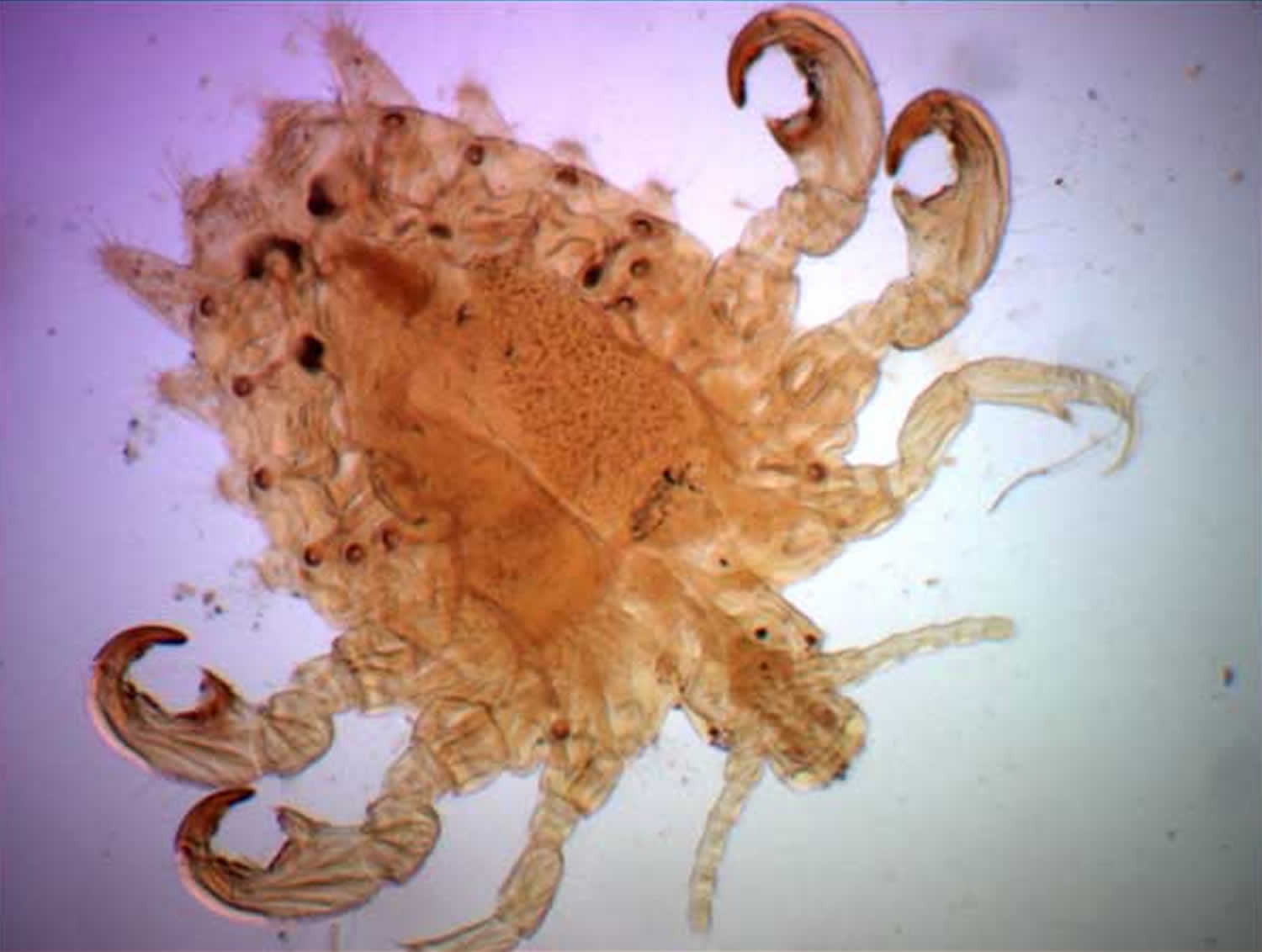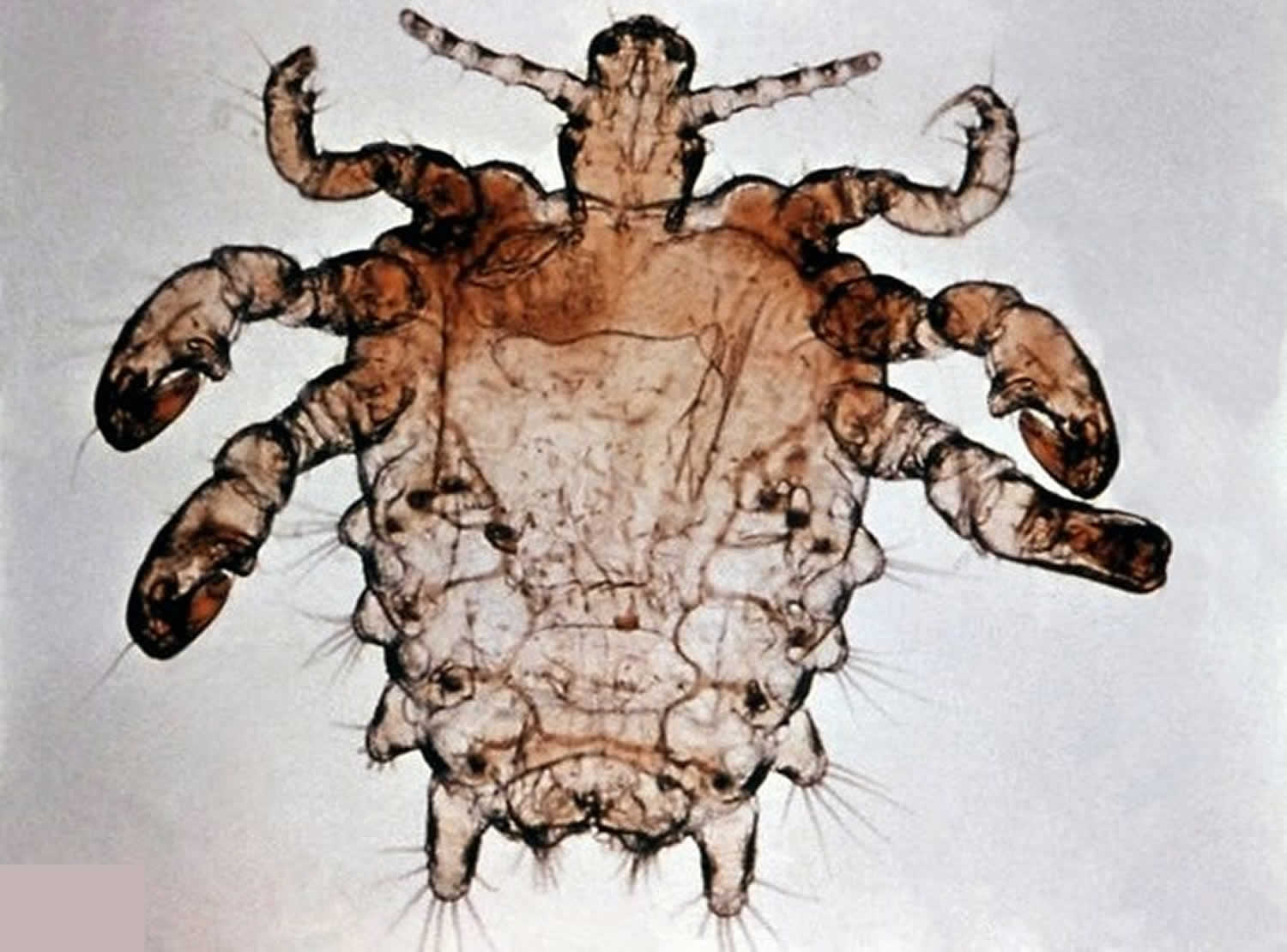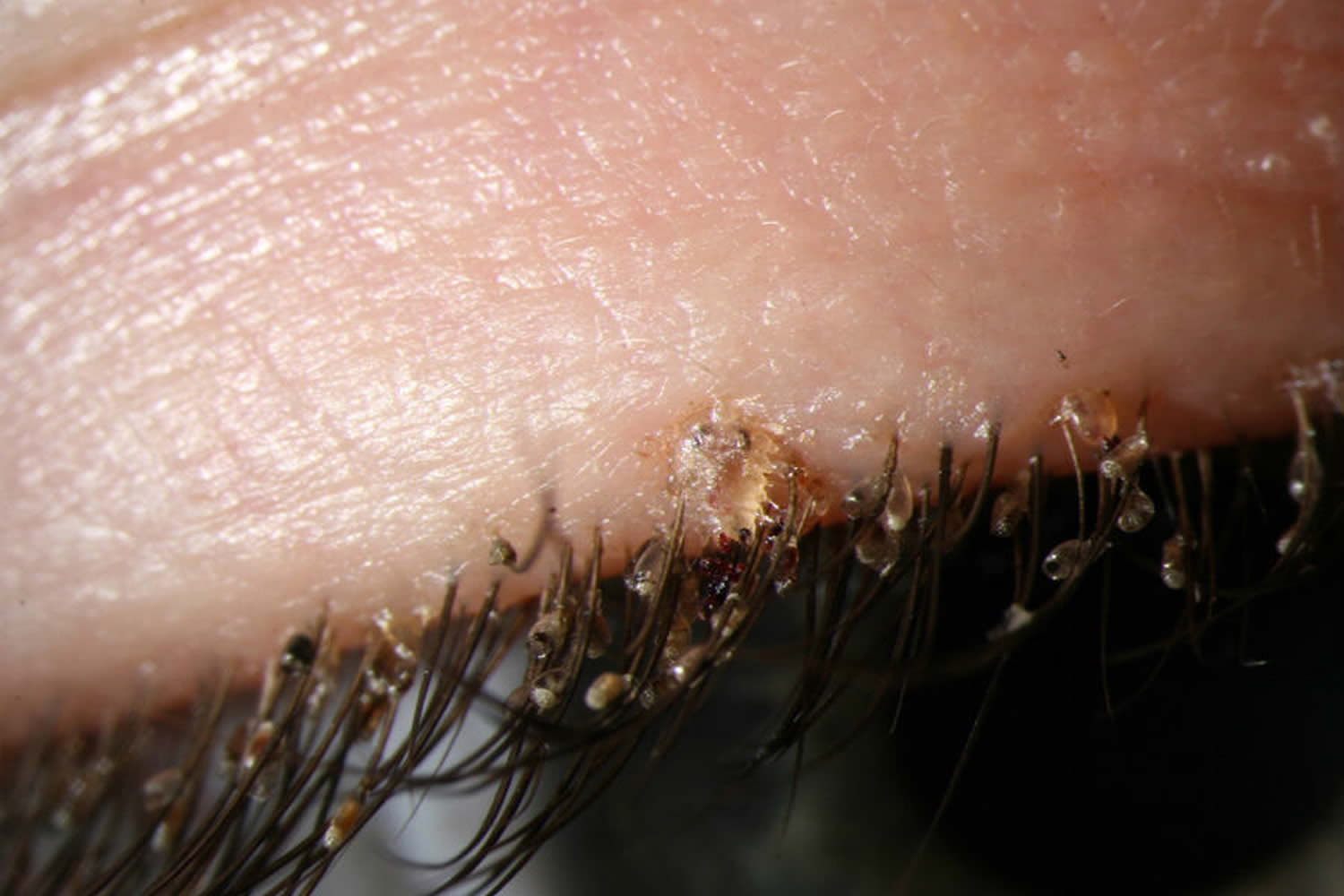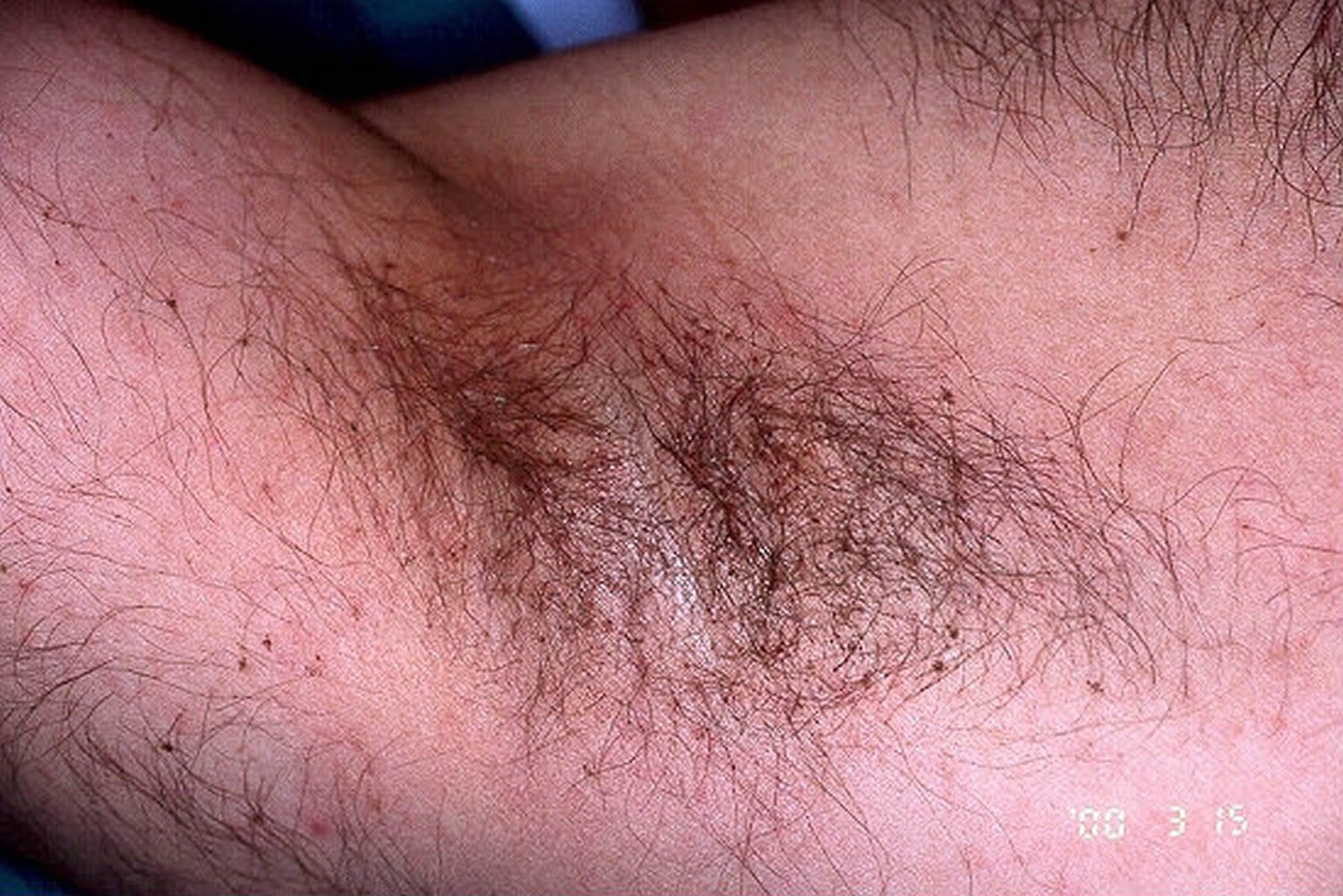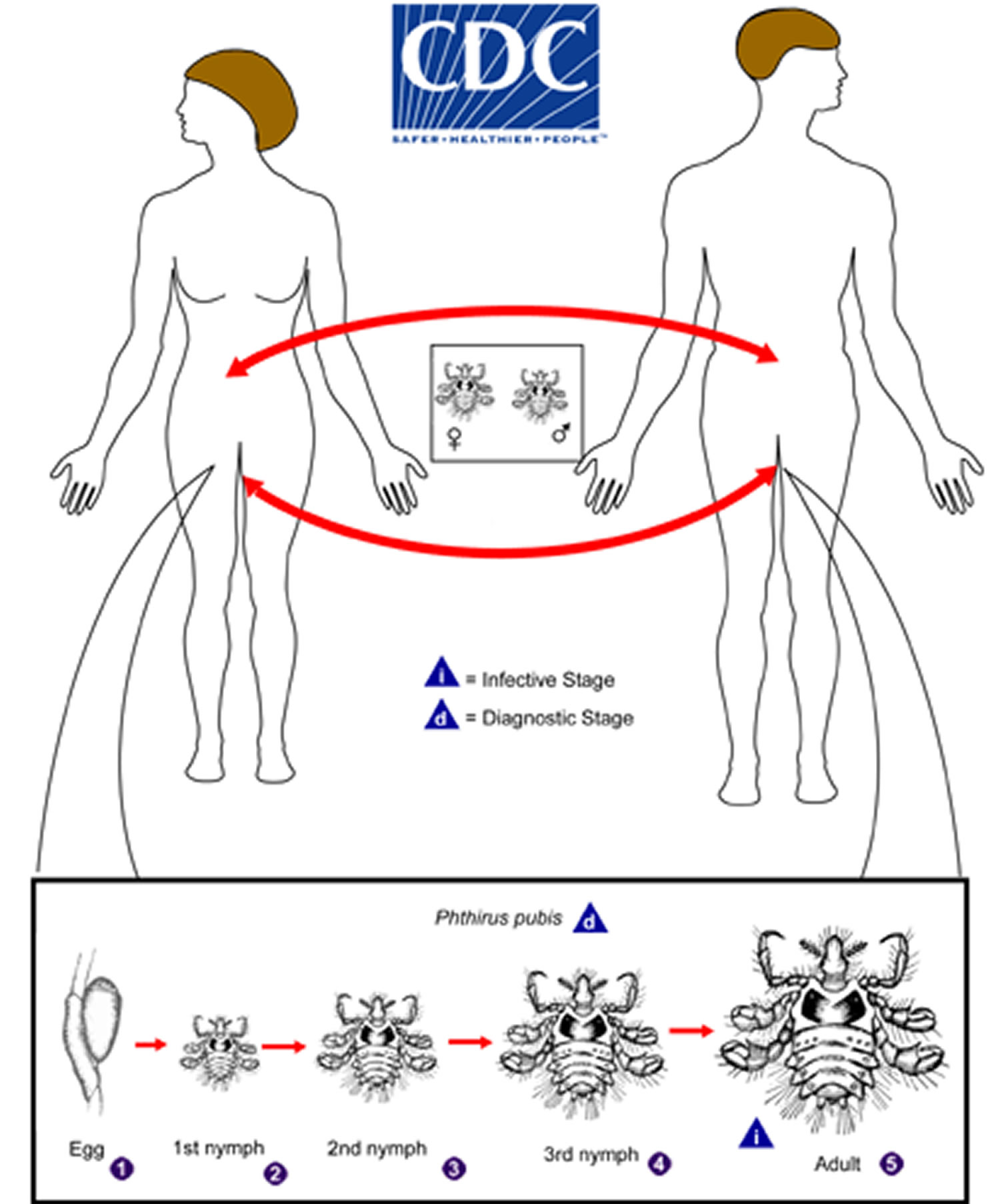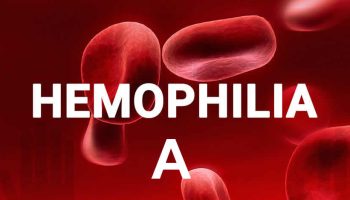Contents
What is pubic lice
Pubic lice or crab lice is also known as Phthirus pubis 1. Pubic lice are commonly referred to as “crabs” because of their short, broad body (about 1 mm), and large front claws. Pubic lice are tiny parasitic insects that live in coarse body hair including pubic hair, eyelashes, beard, mustache, chest, armpits and eyebrows. Pubic lice do not live on your head. Pubic lice do not transmit disease; however, secondary bacterial infection can occur from scratching of the skin.
Pubic lice insect is parasitic, using humans as their primary host, attaching to their host’s thick pubic, perianal region, chest, abdomen and armpits hairs. Adult pubic lice are 1.1–1.8 mm in length, with the first pair of legs much smaller and more slender than the second and third pairs, which resemble the pinchers of a common crab. The abdomen of pubic lice is much shorter compared to that of the head and body louse.
The most common way of spreading pubic lice is from sexual contact (venereal contact). If you or your partner have several sexual partners, you increase your chance of getting pubic lice. You can also catch pubic lice by having close but non-sexual contact with someone who has lice. For example, by kissing someone who has an infested beard or mustache or sleeping in the same bed. Occasionally pubic lice may be spread by close personal contact or contact with articles such as clothing, bed linens, and towels that have been used by an infested person. Once infected, the host develops painless blue-grey macules from the feeding of the lice. The lice and eggs are macroscopic and may cause discomfort via burning or itching. Rarely, pubic lice can be transmitted to a new host via a toilet seat. Dogs, cats, and other pets do not play a role in the transmission of human lice.
Pubic lice found on the head or eyelashes of children may be an indication of sexual exposure or abuse 2.
The female pubic lice lay eggs (smaller than the size of a pin head) that are glued to the hair. These hatch after 6 to 10 days leaving behind empty shells, known as nits. These look like white or grey oval dots on the hair.
The signs you may have pubic lice are:
- itching around your genitals or back passage
- tiny blue spots around your genitals
- spots of blood or fine, gritty debris in your underwear
- visible lice or tiny eggs in your pubic hair.
Both over-the-counter and prescription medications are available for treatment of pubic lice infestations.
If you think you have caught pubic lice from sexual contact, you need treatment with cream/lotion from the pharmacist. You should also consider a visit to you doctor or sexual health clinic so you can be checked for other sexually transmitted infections (STIs).
Pubic lice can be hard to get rid of or can keep coming back, so it is important to treat them quickly and thoroughly.
- You cannot get rid of pubic lice by washing or shaving, as the lice only need a minimal length of hair on which to lay their eggs. You do not need to shave your pubic hair.
- You can treat yourself at home with an insecticidal lotion or cream which is available over the counter from a pharmacy. You will need to repeat this in a week to kill any newly hatched lice.
- Always follow the manufacturer’s instructions when using insecticidal products on yourself or someone else. Over enthusiastic or repeated use of insecticidal products should be avoided as this may cause a secondary contact skin rash.
- Try to avoid scratching the area as this may cause irritation of the skin. There are over the counter medicines that can relieve pain and itching. You should discuss these with a pharmacist.
- To avoid the risk of injuring your eyes, you should not try to remove nits from your eyelashes. If your eyelashes are infested, treatment with a special eye ointment, shampoo or cream rinse will be recommended, to avoid eye irritation, talk to your pharmacist about this.
- To prevent re-infestation, people that you are in close contact with should be treated at the same time. This includes sexual partners and all members of your household, even if they are not yet showing any symptoms.
- Don’t have sex until the pubic lice have been treated.
Reduce the risk of spreading pubic lice by:
- Avoiding close body contact, including hugging and kissing, with anyone until treatment has worked and you are clear of lice.
- Ensure you do not share bed linen or towels with someone who may have lice until they have completed treatment. All linen and towels used during the period of treatment must be washed in a hot water cycle and preferably dried on a hot setting in a clothes dryer.
- Avoiding sexual contact until treatment has worked and you are clear of lice. Ensuring that your sexual partner(s) have been informed and treated otherwise they may re-infest you or infest others.
How to get rid of pubic lice
Both over-the-counter and prescription medications are available for treatment of pubic lice infestations.
A lice-killing lotion containing 1% permethrin or a mousse containing pyrethrins and piperonyl butoxide can be used to treat pubic (“crab”) lice. These products are available over-the-counter without a prescription at a local drug store or pharmacy. These medications are safe and effective when used exactly according to the instructions in the package or on the label.
Typically, an insecticide cream contain maldison/malathion, permethrin, or a pyrethrin is applied directly to the skin and hair and lathered up like shampoo. A small portion may be absorbed into the body and for this reason it is important to follow the manufacturer’s advice on duration of treatment. If you have pubic lice, note the following:
- It is important to apply the shampoo to all hairy parts of the body apart from the eyelids and scalp – from neck to knees.
- The insecticide cream is most easily applied while in the shower.
- Work thoroughly into lather and leave on for five minutes.
- Rinse off thoroughly and dry with a towel.
- Any remaining nits (small white spots attached to hair shaft) should be removed by using a fine toothed comb.
- A repeat application of insecticide is advisable 7-10 days later.
- Insecticide shampoo should not be applied near the eyes. Lice and nits can be removed by using a pair of fine forceps. Alternatively petroleum jelly, such as
- After treating yourself with insecticide, wash your underwear and bed linen thoroughly in hot water to prevent recurrences. Use hot water (at least 130°F or 54 °C) and the hot dryer cycle.
- Sexual partners need to be treated even if they deny itching and do not appear to be infested.
- You may be at risk of other more serious sexually transmitted infections. Persons with pubic lice should be evaluated for other sexually transmitted diseases (STDs). It is advisable to attend your doctor or sexual health clinic for a check-up.
Special instructions for treatment of lice and nits found on eyebrows or eyelashes:
- If only a few live lice and nits are present, it may be possible to remove these with fingernails or a nit comb.
- If additional treatment is needed for lice or nits on the eyelashes, careful application of ophthalmic-grade petrolatum ointment (only available by prescription) to the eyelid margins 2–4 times a day for 10 days is effective. Regular Vaseline should not be used because it can irritate the eyes if applied.
Prescription medications
- Lindane shampoo is a prescription medication that can kill lice and lice eggs. However, lindane is not recommended as a first-line therapy. Lindane can be toxic to the brain and other parts of the nervous system; its use should be restricted to patients who have failed treatment with or cannot tolerate other medications that pose less risk. Lindane should not be used to treat premature infants, persons with a seizure disorder, women who are pregnant or breast-feeding, persons who have very irritated skin or sores where the lindane will be applied, infants, children, the elderly, and persons who weigh less than 110 pounds.
- Malathion lotion 0.5% (Ovide) is a prescription medication that can kill lice and some lice eggs; however, malathion lotion (Ovide) currently has not been approved by the U.S. Food and Drug Administration (FDA) for treatment of pubic (“crab”) lice.
- Both topical and oral ivermectin have been used successfully to treat lice; however, only topical ivermectin lotion currently is approved by the U.S. Food and Drug Administration (FDA) for treatment of lice. Oral ivermectin is not FDA-approved for treatment of lice.
What does pubic lice look like?
Adult pubic lice are very small (2mm long) and aren’t easy to see. They’re a yellow-grey or dusky red color and have six legs.
Pubic lice are sometimes known as crabs because they have two large front legs that look like the claws of a crab. These are used to hold onto the base of hairs.
The lice lay their eggs (nits) in sacs that are stuck firmly to hairs and are a pale brownish color. When the eggs hatch, the empty egg sacs are white.
Although pubic lice and lice eggs are small and difficult to see, they may be visible in coarse hair anywhere on your body (apart from hair on your head).
Figure 1. Pubic lice
Figure 3. Pubic lice eyelash
Figure 4. Pubic lice armpit
Pubic lice life cycle
Pubic lice or Phthirus pubis or crab louse, is an insect of the order Psocodea and is an ectoparasite whose only host are humans.
Pubic lice (Phthirus pubis) have three stages: egg, nymph and adult. Eggs (nits) are laid on a hair shaft (1). Females will lay approximately 30 eggs during their 3–4 week life span. Eggs hatch after about a week and become nymphs, which look like smaller versions of the adults. The nymphs undergo three molts (number 2, 3 and 4) before becoming adults (5). Adults are 1.5–2.0 mm long and flattened. They are much broader in comparison to head and body lice. Adults are found only on the human host and require human blood to survive. If adults are forced off the host, they will die within 24–48 hours without a blood feeding. Pubic lice are transmitted from person to person most-commonly via sexual contact, although fomites (bedding, clothing) may play a minor role in their transmission.
Figure 5. Pubic lice life cycle
Pubic lice symptoms
After getting pubic lice, it can take several weeks before any symptoms appear. Symptoms are the same for men and women and include:
- itching in the affected areas
- inflammation and irritation caused by scratching
- black powder in your underwear
- blue spots or small spots of blood on your skin, such as on your thighs or lower abdomen (caused by lice bites)
Itching (“pruritus”) in the pubic and groin area is the most common symptom of pubic lice infestation and is an allergic reaction to their saliva. The itching is usually worse at night, when the lice are most active. As with other lice infestations, intense itching leads to scratching which can cause sores and secondary bacterial infection of the skin.
Visible lice eggs (“nits”) or lice crawling or attached to pubic hair, or less commonly other hairy areas of the body (eyelashes, eyebrows, beard, mustache, armpits, chest, back) are other signs of pubic lice infestation.
Pubic lice on the head (eyelashes or eyebrows) of a child may be an indication of sexual exposure or abuse.
Persons infested with pubic lice should be evaluated for other sexually transmitted diseases (STDs).
Complications of pubic lice
Sometimes, a pubic lice infestation can lead to minor complications, such as skin or eye problems.
Scratching can irritate your skin, or it could lead to an infection such as impetigo (a bacterial skin infection) or furunculosis (boils on the skin).
Eye infections, such as conjunctivitis, and eye inflammation, such as blepharitis, can sometimes develop if your eyelashes have been infested with pubic lice.
Seek medical advice if you have severe skin irritation or sore eyes.
How do you get pubic lice?
Pubic lice are contracted by close contact and are easily transmitted sexually including vaginal, anal and oral sex. Using condoms and other methods of barrier contraception doesn’t protect you against pubic lice. Pubic lice have become very uncommon in developed countries since shaving of pubic hair has become popular. Pubic lice crawl from hair to hair, but can’t fly or jump. Pubic lice need human blood to survive, so will only leave the body to move from one person to another.
Other types of close bodily contact, such as hugging and kissing, can also spread the lice.
It’s also possible – though much rarer – for pubic lice to be spread through sharing clothes, towels and bedding.
Where do pubic lice live and how do they grow?
The lice are most often found within the pubic hair but pubic lice can spread to other hairy parts of the body including armpit, beard, chest hair and thigh hair. Eyelashes can also be infested. The large claws of pubic lice allow them to grasp onto coarser pubic hairs in the groin, perianal, and axillary areas. Like other human lice they use their mouthparts to suck blood for nutrition and at the same time inject a saliva that causes itching. Pubic lice cannot survive more than one day without feeding off their human host.
Blood specks are occasionally noted on underclothes and live lice may be seen moving in the pubic hair. Tiny bleeding spots or bite marks may be noted within the pubic hairs.
Getting tested for sexually transmitted infections
You should be tested for other sexually transmitted infections (STIs) if you have pubic lice through sexual contact. The lice don’t transmit HIV or other STIs, but a check-up is usually recommended as a precaution.
Any sexual partners you’ve had over the last three months will also need to be seen and treated. If you prefer, staff at the clinic can contact a person on your behalf without releasing your details.
Pubic lice prevention
Pubic (“crab”) lice most commonly are spread directly from person to person by sexual contact. Pubic lice very rarely may be spread by clothing, bedding, or a toilet seat.
The following are steps that can be taken to help prevent and control the spread of pubic (“crab”) lice:
- All sexual contacts of the infested person should be examined. All those who are infested should be treated.
- Sexual contact between the infested person(s)s and their sexual partner(s) should be avoided until all have been examined, treated as necessary, and reevaluated to rule out persistent infestation.
- Machine wash and dry clothing worn and bedding used by the infested person in the hot water (at least 130°F) laundry cycle and the high heat drying cycle.
- Clothing and items that are not washable can be dry-cleaned OR sealed in a plastic bag and stored for 2 weeks.
- Do not share clothing, bedding, and towels used by an infested person.
- Do not use fumigant sprays or fogs; they are not necessary to control pubic (“crab”) lice and can be toxic if inhaled or absorbed through the skin.
Persons with pubic lice should be examined and treated for any other sexually transmitted diseases (STDs) that may be present.
Pubic lice diagnosis
Pubic lice are short and crab-like and appear very different from head and body lice. Pubic lice infestation is diagnosed by finding a “crab” louse or eggs on hair in the pubic region or less commonly, elsewhere on the body (eyebrows, eyelashes, beard, mustache, armpit, perianal area, groin, trunk, scalp). Although pubic lice and nits can be large enough to be seen with the naked eye, a magnifying lens may be necessary to find lice or eggs.
- The lice are ‘crab’-shaped, grey-brown in color, and about 2 mm in length – a fine-toothed comb may be useful for detection
- Eggs are smaller than a pinhead
Louse feces are often visible as rust-colored speckles on the skin, hair and underwear
When pubic lice are discovered other hairy areas of the body should be examined, as these lice may colonize the eyebrows, eyelashes, beard, axillae, areolar hair and the scalp margins. In more severe cases, the hair on the trunk and limbs may also be affected
Pubic lice treatment
Pubic lice are killed by insecticides. The insecticides usually contain maldison/malathion, permethrin, or a pyrethrin. Topical ivermectin has been used effectively off-label.
A lice-killing lotion containing 1% permethrin or a mousse containing pyrethrins and piperonyl butoxide can be used to treat pubic (“crab”) lice. These products are available over-the-counter without a prescription at a local drug store or pharmacy. These medications are safe and effective when used exactly according to the instructions in the package or on the label.
Lindane shampoo is a prescription medication that can kill lice and lice eggs. However, lindane is not recommended as a first-line therapy. Lindane can be toxic to the brain and other parts of the nervous system; its use should be restricted to patients who have failed treatment with or cannot tolerate other medications that pose less risk. Lindane should not be used to treat premature infants, persons with a seizure disorder, women who are pregnant or breast-feeding, persons who have very irritated skin or sores where the lindane will be applied, infants, children, the elderly, and persons who weigh less than 110 pounds.
Malathion lotion 0.5% (Ovide) is a prescription medication that can kill lice and some lice eggs; however, malathion lotion (Ovide) currently has not been approved by the U.S. Food and Drug Administration (FDA) for treatment of pubic (“crab”) lice.
Both topical and oral ivermectin have been used successfully to treat lice; however, only topical ivermectin lotion currently is approved by the U.S. Food and Drug Administration (FDA) for treatment of lice. Oral ivermectin is not FDA-approved for treatment of lice.
How to treat pubic lice infestations: (Warning: See special instructions for treatment of lice and nits on eyebrows or eyelashes. The lice medications described in this section should not be used near the eyes.)
- Wash the infested area; towel dry.
- Carefully follow the instructions in the package or on the label. Thoroughly saturate the pubic hair and other infested areas with lice medication. Leave medication on hair for the time recommended in the instructions. After waiting the recommended time, remove the medication by following carefully the instructions on the label or in the box.
- Following treatment, most nits will still be attached to hair shafts. Nits may be removed with fingernails or by using a fine-toothed comb.
- Put on clean underwear and clothing after treatment.
- To kill any lice or nits remaining on clothing, towels, or bedding, machine-wash and machine-dry those items that the infested person used during the 2–3 days before treatment. Use hot water (at least 130°F or 54 °C) and the hot dryer cycle.
- Items that cannot be laundered can be dry-cleaned or stored in a sealed plastic bag for 2 weeks.
- All sex partners from within the previous month should be informed that they are at risk for infestation and should be treated.
- Persons should avoid sexual contact with their sex partner(s) until both they and their partners have been successfully treated and reevaluated to rule out persistent infestation.
- Repeat treatment in 9–10 days if live lice are still found.
- Persons with pubic lice should be evaluated for other sexually transmitted diseases (STDs).
Special instructions for treatment of lice and nits found on eyebrows or eyelashes:
- If only a few live lice and nits are present, it may be possible to remove these with fingernails or a nit comb.
- If additional treatment is needed for lice or nits on the eyelashes, careful application of ophthalmic-grade petrolatum ointment (only available by prescription) to the eyelid margins 2–4 times a day for 10 days is effective. Regular petrolatum (e.g., Vaseline) should not be used because it can irritate the eyes if applied.
